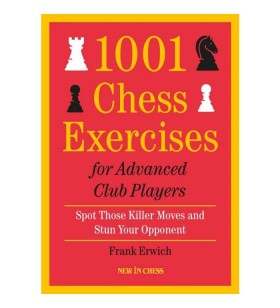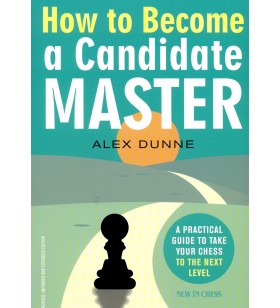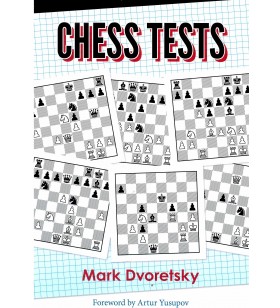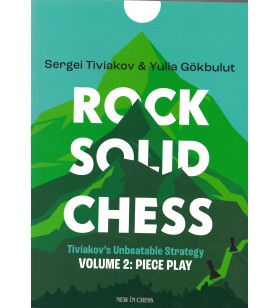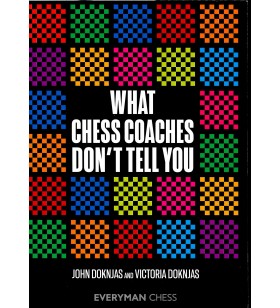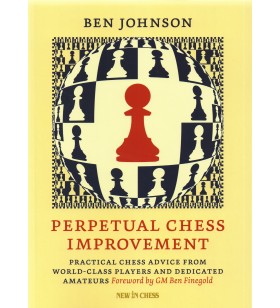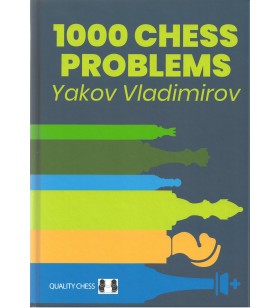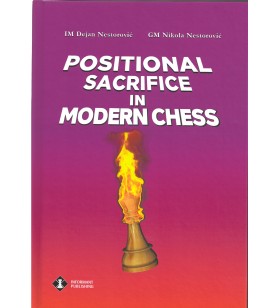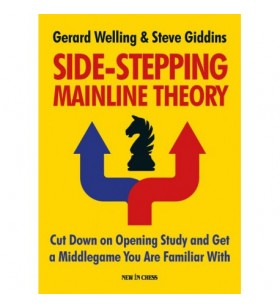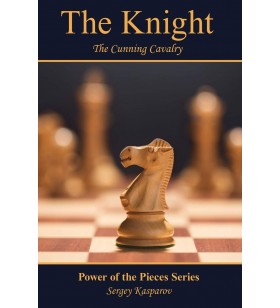- SCHAAK
- DENKSPELLEN
- GO
- BRIDGE, TAROT & KAARTEN
- POKER & CASINO
- PUZZLES & BRAINBREKERS
- DARTS
PRITCHETT - Chess for Rookies
 Livraison sous 48 heures via Bpost*
Livraison sous 48 heures via Bpost*
Gratis levering vanaf €69 (België, Frankrijk, Nederland, Luxemburg, Duitsland)
 U kunt uw bestelling annuleren
U kunt uw bestelling annuleren
Veertien dagen lang!
 Beveiligde betalingen
Beveiligde betalingen
Alle betaalkaarten geaccepteerd.
16 ander product
Tiviakov/Gökbulut - Rock Solid Chess Volume 2
Sergei Tiviakov was unbeaten in a streak of more than a hundred chess games as a professional player. Who better to share the secrets of Rock Solid Chess and the activity and value of pieces than Tiviakov?
The highly acclaimed first volume of his chess strategy trilogy dealt with pawn structures. In this second volume, Sergei moves on to discuss piece play and unique chessboard situations. Topics covered include the bishop pair, opposite-coloured bishops, centralization and the almost-ignored question of when and whether to castle.
Tiviakov also demonstrates how the value of pieces can vary drastically depending on their exact position. He shows how the entire assessment of a position, and the correct strategy for playing it, can be changed by moving a single pawn from one square to another.
In the final chapters, Tiviakov discusses how to play cramped and passive positions, how to play for a win with Black and how to choose your strategy, based on the opponent’s style and other psychological factors.
Illustrated with examples from classic games and from his own games, and supported by instructive exercises, Volume Two of Rock Solid Chess offers invaluable and unique instruction on topics not covered in traditional textbooks. These strategy lessons will significantly improve your chess and are suitable for all readers, from club players to grandmasters.
Sergei Tiviakov is a grandmaster, Olympic gold medallist, three-time Dutch Champion and European Champion.
Yulia Gökbulut is a FIDE Women's Master, chess author and sports writer from Turkey.
251 pages
Doknjas - What chess coaches don't tell you
Are you a parent of a junior chess player who feels that because you don’t know how to play chess, you can’t help your child? Or are you an adult or junior chess player who has taken private chess lessons for years, but feels you haven’t been progressing?
In both cases, there can be a lot of reliance on a chess coach who has been given free rein with lesson content and direction. They probably have some sort of plan but it is likely to be a plan used for all their students. This is not ideal. More important is a well-thought out, individualized plan, that focuses on a specific player’s unique strengths and weaknesses. Formulating such a plan is crucial for making improvements.
Victoria Doknjas and her son John Doknjas are an ideal writing partnership to tackle this topic. John is a FIDE Master who has already established himself as an excellent and highly-respected author who understands the improvement process very well. Victoria has over a decade of experience navigating the competitive chess arena with her three master-level sons, including also running her own chess academy. Together they offer a unique and informative insight to those wanting to get more out of their chess studies, as well as presenting practical advice in areas including:
- Identifying important goals and how to work towards them.
- Understanding how to objectively analyse your games.
- Maximising the efficiency of software and engines for learning.
Reading this book can broaden your horizons in the essential areas of chess study, and ideally let you better evaluate what your chess coach is teaching you. And if you don’t have a chess coach, this book will provide you with an excellent foundation for serious chess study.
384 pages
Johnson - Perpetual Chess Improvement
Perpetual Chess Improvement : Practical Chess Advice from World-Class Players and Dedicated Amateurs, by Ben Johnson. In a world awash in educational chess content, knowing how to study the game most effectively can be challenging.
As the Perpetual Chess Podcast host, USCF Master Ben Johnson has spent hundreds of hours talking chess with many of the world’s top players and most accomplished trainers. In the popular Adult Improver Series, he has spoken with dozens of passionate amateurs who have elevated their games significantly while pursuing chess as a hobby.
Guests like former World Champion Viswanathan Anand and YouTube Stars IM Levy Rozman and GM Hikaru Nakamura have shared insights and told memorable stories. And Ben has learned just as much from the many dedicated amateurs who applied their considerable professional (non-chess) experience to their chess learning.
In Perpetual Chess Improvement, Ben looks for common ground and shared principles in all chess advice given on the podcast. Chess players do not always agree on the best improvement methods, so he even adjudicates a few disagreements! The book will show you the following:
- How to approach and study different aspects of the game, including openings, endgames, tactics, tournament games, and speed chess.
- How to find a chess coach and a like-minded chess community.
- How to properly utilize all the powerful chess study tools available.
- Instructive chess positions illustrate the topics discussed.
The guests shared a wealth of beautiful stories, and chess study advice on the Perpetual Chess Podcast. This book compiles the highlights and will help you make a holistic plan for your chess studies.
Ben Johnson is a USCF Master and accomplished chess coach. In 2016, he started the Perpetual Chess Podcast, the most successful chess podcast, with over five million downloads and streams in over a hundred different countries - and counting. Ben grew up in Philadelphia and lives in New Jersey with his family. Before dedicating his life to chess, he was a professional poker player and a stock trader.
245 pages
Gormally - Tournament Battle Plan
Books on how to improve your results over the board have been written before but in these changing times when chess has propelled onto the public consciousness, an update is badly needed. Grandmaster Daniel Gormally uses his 25+ years of experience to take the readers through the fires of the tournament cauldron, while illustrating some of his battles with the best players in England.
Along the way he tackles how to approach online play, an increasingly important issue as this form of chess has increased in popularity. Do you need a coach ? Will streamers relly help you to improve ? And should you turn off your computer ? Gormally emphasizes the importance of independent analysis in enabling the player to make progress and explains how he himself suffered in his results due to an over-reliance in chess engines.
And then there is the nitty gritty of tournament play itself. Gormally grapples with subjects that aren't covered in normal tournament books, from what hotels you should choose, to what kind of diet you need to follow, while also concluding that he lacks the awesome physical fitness of the Norwegian chess god Magnus Carlsen.
It all culminates in an explosive Hastings diary, where the author uses his acerbic wit to pull apart the vagaries of preparing for international competition in an account that verges on comic-tragic. 348 pages
Nestorovic - Positional sacrifice in modern chess
Positional Sacrifice in Modern Chess (hardcover). A Word from the Authors : "The sequel, or the second part of the “Secrets of Positional Sacrifice” manual is titled “Positional Sacrifice in Modern Chess”. We assume that readers will conclude that the subject of our analysis are recently played games, especially the games played over the last few years. The book is intended for chess players who aspire to raise the level of positional play in this particular field of expertise, as well as coaches working on chess education. Like the previous book “Secrets of Positional Sacrifice”, the book in our hands is divided into chapters according to the material that is the subject of the sacrifice: the positional sacrifice of a pawn, exchange, piece, rook, and queen. Finally, the last chapter deals with “hot games” and contains six games played during November and December 2021. We believe that the book is as interesting and instructive as its prequel. However, the examples are a tad more complicated, primarily because of the positional rook sacrifice section. In actual fact, the examples on this kind were verydifficult to find in practice, and processing them in the right way was a particular challenge for us. The first section, the positional pawn sacrifice, should encourage the reader to execute one of the most complicated positional sacrifices in practice as often as possible. On the other hand, the sacrifice of exchange is the most common and easiest to apply and can very successfully serve as a means of relieving the fear of possible sacrifice of material. Asymmetric positions, i.e., positions with an unusual distribution of material, are mostly featured in the positional piece and queen sacrifice positions. In the last chapter entitled “Hot Games,” we present the analysis on the topics of various fascinating examples, from the latest games of today’s great players. We tried to choose the examples that were easy to follow, so they are embellished with diagrams and explained verbally as well. We paid more attention to the analysis of the positional sacrifice from the moment of its execution to the end of the game. Hence, the introductory part of each example may be somewhat shorter in relation to the first book. Finally, the invaluable exercises at the end of the book should be mentioned. The tasks cover four topics to make them as interesting and easy to solve as possible. The exercises are based on the correct assessment of asymmetric positions and, of course, on concrete calculations. In conclusion, we would like to emphasize that the book highlights the beauty of human ideas and their practical application. In some cases, the authors give preference to the human idea over the assessment of the computer. When a player cannot calculate complicated lines accurately, he should look for an alternative solution of the similar quality. One of the possible answers is the positional sacrifice that leads to asymmetric material and thus the change of the character of the fight. " Hardcover. 307 pages

 Français
Français Nederlands
Nederlands English
English



